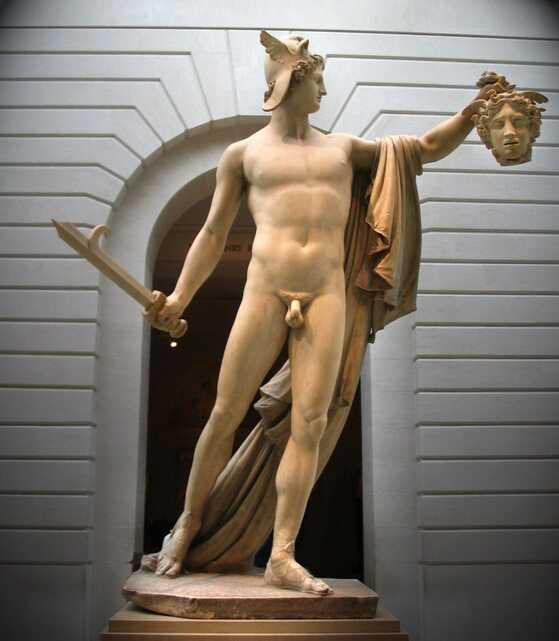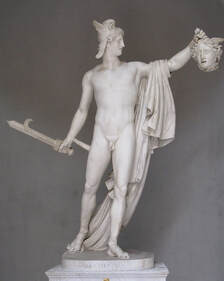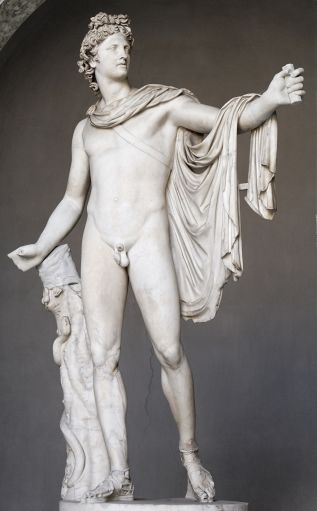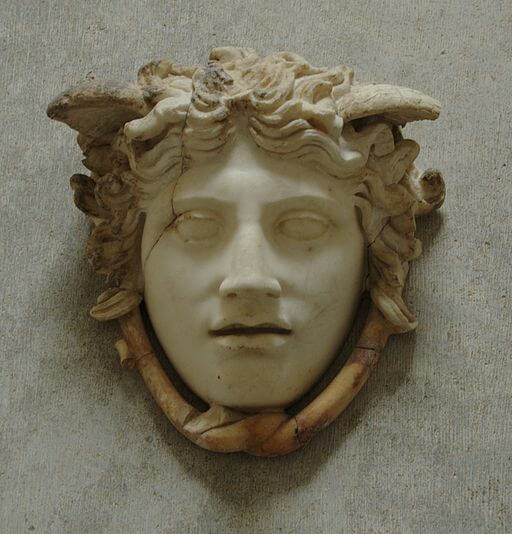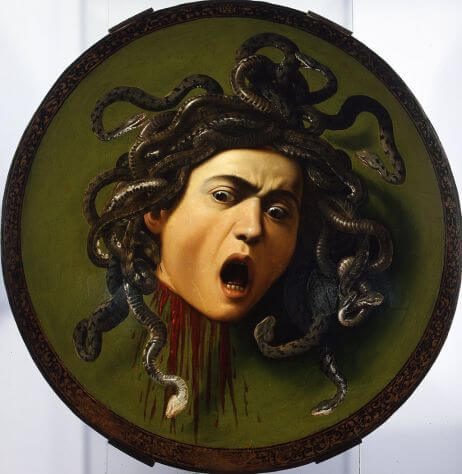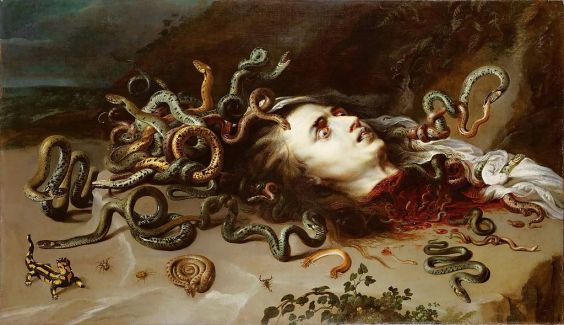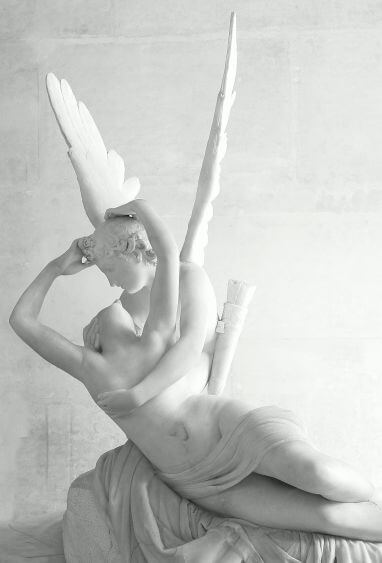What do you see? This marble statue shows the Greek demigod Perseus holding the head of Medusa. Perseus is standing in a triumphant pose as he has just beheaded Medusa. He holds the head of Medusa in his left hand by grabbing the venomous snakes on her head. The face of Medusa expresses horror as it has just been cut off. However, you can also still see the beauty of her face.
Interestingly, Perseus is looking at her face, even though that should turn him into stone according to the myth (but the irony may be that this actually happened in this statue). Perseus is wearing the sandals of the Roman messenger god Mercury (Hermes in Greek) which allowed Perseus to fly. These sandals were made of gold by the god Vulcan (Hephaestus in Greek). Perseus also wears the cap of Hades, which could make him invisible. In his right hand, Perseus is holding a harpe sword, which is a sword with a sickle-like extension on one side of the blade. The sword was owned by Zeus, the father of Perseus. A robe hangs loosely over his arm. Notice that his left foot is standing in the front, while the heel of his right foot is lifted. In this way, Canova creates the sense that Perseus is moving forward.
Backstory: Antonio Canova made this statue twice. The first version is on display in the Vatican Museums and is also known as Perseus Triumphant. A replica by Canova is in the Metropolitan Museum of Art. The head of Medusa in this statue has been inspired by the Medusa Rondanini, a marble sculpture that is in the Glyptothek in Munich.
The rest of the statue has been heavily inspired by the Apollo Belvedere, a famous statue from antiquity, which is also in the Octagonal Court of the Vatican Museums. The first version of the statue of Perseus and Medusa was acquired by Pope Pius VII to replace the Apollo Belvedere which Napoleon Bonaparte had confiscated and shipped to the Louvre in Paris. When the Apollo Belvedere returned to Rome, they kept the statue of Canova as it was such a great piece of work. When the second version of this statue first arrived at the Metropolitan Museum of Art, the sword was missing. They took a cast from the version in the Vatican Museums and added a newly carved marble sword to the statue.
The story of Perseus and Medusa: In Greek mythology, Perseus is the son of Jupiter (Zeus in Greek), who was the king of the gods, and Danaë. Polydectes, the King of Seriphos, ordered Perseus to provide him with the head of Medusa as a wedding gift for him.
Medusa was one of three sisters (Stheno, Euryale, and Medusa) who were often referred to as Gorgons. Both Stheno and Euryale were immortal, but Medusa was not. According to the Roman poet Ovid, Medusa was a beautiful young woman. However, after Poseidon (the god of the sea) made love to her in Athena’s temple, Athena (the goddess of wisdom and war) changed her beautiful locks into living, venomous snakes (in other mythological stories the three sisters were already born with snakes on their heads). Medusa had a horrific facial expression that could turn people (or according to some, only men) who looked at her into stone. Perseus used a shiny shield that he got from Athena to avoid looking at Medusa directly and succeeded to cut off her head. When Perseus returned to King Polydectes, he showed him the head of Medusa, which still retained its power, which turned Polydectes into stone. This was the purpose of Perseus as he discovered that Polydectes had abused his mother. Perseus and Medusa in art? Perseus and Medusa have been a popular subject in art. Famous artists have used their story as the inspiration for their artwork. Leonardo da Vinci created two version of the head of Medusa, but neither of them has survived. Caravaggio has painted the head of Medusa on a shield which is in the Uffizi Museum. Rubens also created two versions of the Head of Medusa, of which one is in the Kunsthistorisches Museum in Vienna. Various sculptures of Perseus and Medusa have also been made, such as one by Benvenuto Cellini.
What is neoclassicism? Around 1760, neoclassicism started in Rome in opposition to the then-popular Baroque and Rococo styles. The neoclassic style quickly spread through Europe and become especially popular in France, with artists such as Jacques-Louis David and Jean-Auguste-Dominique Ingres.
Neoclassic art is inspired by the old Roman and Greek art and focuses on simplicity and symmetry. The paintings, sculptures, and architecture in this style did not show much emotion, were more ordered and down-to-earth compared to the Baroque style and were less playful compared to the Rococo style. Fun fact: When making a statue of marble, the artist needs to be aware of the center of gravity. In this sculpture, the stretched arm of Perseus and the head of Medusa naturally shift the center of gravity. Canova included two tricks to keep the sculpture stable and decrease the chances that it gets severely damaged by movement or that the head would simply break off.
Written by Eelco Kappe
References:
0 Comments
Leave a Reply. |
Categories
All
|
- Home
- Blog
-
Museums
- Alte Pinakothek
- Art Institute of Chicago
- Baltimore Museum of Art
- Barber Institute of Fine Arts
- Bargello
- Barnes Foundation
- British Museum
- Church of Sant’Anastasia
- Cleveland Museum of Art
- Courtauld Institute of Art
- Detroit Institute of Arts
- Frans Hals Museum
- Galleria Borghese
- Gallerie dell'Accademia
- Getty Museum
- Guggenheim
- Hermitage Museum
- Kunsthistorisches Museum
- Kunstmuseum Basel
- Legion of Honor Museum
- Louvre
- Mauritshuis
- Metropolitan Museum of Art
- Musee d’Orsay
- Museum of Fine Arts in Boston
- Museum of Modern Art
- National Gallery in London
- National Gallery of Art
- National Museum in Poznań
- Norton Simon Museum
- Ny Carlsberg Glyptotek
- Palace of Versailles
- Palazzo Pitti
- Palazzo Vecchio
- Petit Palais
- Philadelphia Museum of Art
- Prado
- Pushkin Museum
- Ravenna Art Museum
- Rijksmuseum
- San Diego Museum of Art
- Santa Maria delle Grazie
- St. Peter's Basilica
- Städel Museum
- Statens Museum for Kunst
- Tate Britain
- Tate Modern
- Timken Museum of Art
- Uffizi
- Vatican Museums
- Wallace Collection
-
Artists
- Altdorfer
- Anguissola
- Berlin Painter
- Bosch
- Botticelli
- Boucher
- Bronzino
- Bruegel the Elder
- Brunelleschi
- Cabanel
- Caillebotte
- Canova
- Caravaggio
- Carpeaux
- Cezanne
- Cimabue
- David
- Degas
- Delacroix
- De Maria
- Donatello
- El Greco
- Fontana
- Fra Angelico
- Fragonard
- Gauguin
- Gentileschi
- Gericault
- Gonzalez-Torres
- Goya
- Hals
- Hogarth
- Hokusai
- Ingres
- Leonardo da Vinci
- Lippi, Filippo
- Longhi, Barbara
- Lorrain
- Makovsky
- Manet
- Massys
- Matisse
- Merian
- Michelangelo
- Mochi
- Modigliani
- Monet
- Panini
- Parmigianino
- Perugino
- Picasso
- Pisanello
- Raphael
- Rembrandt
- Renoir
- Reynolds
- Rivera
- Rodin
- Rubens
- Scultori
- Seurat
- Steen
- Tintoretto
- Titian
- Toulouse-Lautrec
- Turner
- Uccello
- Van der Weyden
- Van Dyck
- Van Eyck
- Van Gogh
- Van Hemessen
- Vasari
- Velazquez
- Vermeer
- Veronese
- Vigée Le Brun
-
Locations
- Books
- About Us

